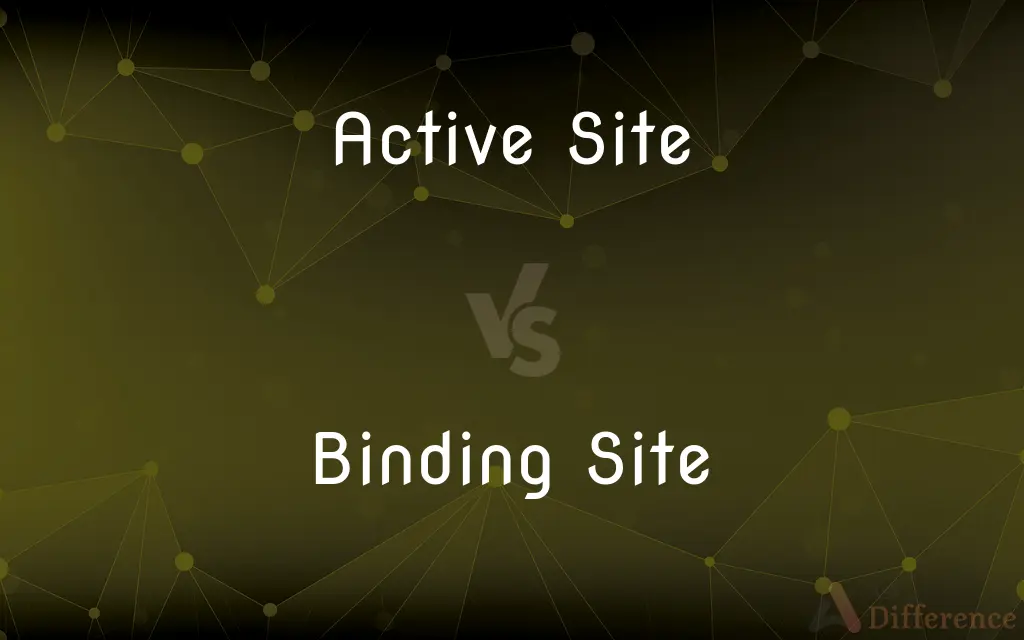Active Site vs. Binding Site — What's the Difference?
By Tayyaba Rehman — Published on November 1, 2023
Active Site is a region on an enzyme where the substrate binds, and a reaction occurs, while Binding Site is the location on a protein where a specific molecule can attach.

Difference Between Active Site and Binding Site
Table of Contents
ADVERTISEMENT
Key Differences
The Active Site is a specific region on the surface of an enzyme where the substrate binds and the catalytic action occurs. In contrast, the Binding Site refers to any area on a protein, including enzymes, where a specific molecule, not necessarily a substrate, can attach itself.
Enzymes facilitate biochemical reactions, and their Active Site is specialized for the substrate it interacts with, allowing for catalytic reactions to take place. The Binding Site, while similar in the concept of molecular interaction, doesn't exclusively denote a site of catalysis. Instead, it can be any part of a protein where a ligand, ion, or another molecule can bind.
When discussing function, the Active Site plays a direct role in accelerating reactions. Its structure and chemical properties ensure that the enzyme can interact effectively with its substrate. On the other hand, the Binding Site may not always directly influence function but might play roles in stabilization, protein structure, or signaling when molecules bind to it.
In many instances, an enzyme's Active Site is also its Binding Site since the substrate first binds and then undergoes a reaction. However, not all Binding Sites are Active Sites, as proteins may have multiple regions where various molecules can attach without a subsequent catalytic reaction.
Lastly, specificity is a key trait for both sites. The Active Site is often incredibly selective, ensuring that only the correct substrate binds and reacts. Similarly, Binding Sites possess selectivity, ensuring specific interactions with the desired molecules.
ADVERTISEMENT
Comparison Chart
Function
Catalyzes reactions
Allows molecules to attach
Specificity
Highly specific to its substrate
Specific to its binding molecule, but not necessarily a substrate
Location
Specific region on enzymes
Any area on a protein
Result of Binding
Chemical reaction occurs
Attachment; may not result in a reaction
Interaction
Interacts with substrates
Can bind ligands, ions, or other molecules
Compare with Definitions
Active Site
Area facilitating enzyme-substrate complexes.
When the substrate binds to the Active Site, the enzyme undergoes a conformational change.
Binding Site
The location on a molecule for selective binding.
The drug's Binding Site on the target protein results in therapeutic effects.
Active Site
Region on an enzyme for substrate interaction.
The enzyme's Active Site binds to its substrate, initiating the reaction.
Binding Site
Protein region where molecules attach.
The protein has a specific Binding Site for the hormone.
Active Site
The enzyme's catalytic center.
The Active Site possesses the right conditions to accelerate the chemical reaction.
Binding Site
Region ensuring specific molecular attachments.
The enzyme has a Binding Site separate from its Active Site for regulatory molecules.
Active Site
Specific pocket where reactions occur on an enzyme.
The substrate fits perfectly into the enzyme's Active Site, like a key in a lock.
Binding Site
Specific pocket allowing molecular interactions.
The neurotransmitter finds its Binding Site on the receptor protein.
Active Site
Location where catalysis takes place.
The enzyme's Active Site lowers the reaction's activation energy.
Binding Site
Area on a protein for ligand interaction.
The ion's Binding Site on the receptor ensures stable attachment.
Common Curiosities
How does a Binding Site differ from an Active Site?
A Binding Site is any area on a protein where a molecule can attach, while an Active Site is specifically where substrate binding and reactions occur on enzymes.
Can a protein have multiple Binding Sites?
Yes, proteins can have several Binding Sites, each specific to different molecules.
Is the Active Site always active?
No, factors like pH, temperature, and inhibitors can impact an Active Site's functionality.
Are all Active Sites also Binding Sites?
Yes, since substrates must bind to the Active Site before a reaction can occur.
Why are Binding Sites important in drug design?
Recognizing specific Binding Sites helps in designing drugs that can bind and modulate protein function.
What's an Active Site?
The Active Site is a region on an enzyme where the substrate binds and a catalytic reaction occurs.
Do all proteins have an Active Site?
No, only enzymes have Active Sites. However, all proteins can have Binding Sites.
What determines an Active Site's specificity?
The shape, size, and amino acid properties of the Active Site determine its specificity to substrates.
Can an enzyme have multiple Active Sites?
Yes, some multi-subunit enzymes have multiple Active Sites.
What can affect the functionality of a Binding Site?
Changes in protein structure, mutations, or the presence of competing molecules can impact a Binding Site.
Can molecules other than substrates bind to the Active Site?
Yes, inhibitors can bind to the Active Site, preventing substrates from binding and reactions from occurring.
Can the environment influence an Active Site's function?
Yes, factors like pH, temperature, and salt concentration can influence an Active Site's activity.
Do Binding Sites always result in a biochemical reaction?
No, while Binding Sites allow molecules to attach, they don't necessarily cause a reaction.
Why is the fit between an Active Site and its substrate compared to a lock and key?
The specificity and exact fit of a substrate to its Active Site resemble how only the right key fits a lock.
What's the significance of the shape of a Binding Site?
The shape ensures the specific and selective binding of the right molecule.
Share Your Discovery

Previous Comparison
Section vs. Cross Section
Next Comparison
Short-Term vs. Long-TermAuthor Spotlight
Written by
Tayyaba RehmanTayyaba Rehman is a distinguished writer, currently serving as a primary contributor to askdifference.com. As a researcher in semantics and etymology, Tayyaba's passion for the complexity of languages and their distinctions has found a perfect home on the platform. Tayyaba delves into the intricacies of language, distinguishing between commonly confused words and phrases, thereby providing clarity for readers worldwide.
















































